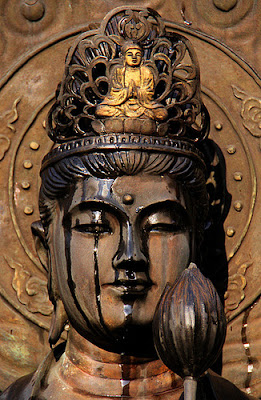 |
| A Sho Kannon statue at a small rural Zen temple in Iwami, Shimane. |
The people of Korea once commissioned an artist in Cheh-kiang, China, to carve a life-sized wooden statue of Avalokiteshvara. The work was completed, the statue carried to Tsien-t‘ang harbor for shipment, when suddenly it seemed to be stuck fast to the beach, and no human power could move it. After negotiations between the Chinese and Koreans, it was decided to keep the statue in China. The statue then returned to its normal weight and was later enshrined at a temple in Ming-chou. A person paid homage to the statue and said, “In the sutra we read that Avalokiteshvara is the possessor of miraculous powers, and in all the lands of the ten quarters there is not a place where he does not manifest himself. Then why is it this holy statue refused to go to Korea?”
GENRO: Every place is the land of his manifestation, then why should he go particularly to Korea?
One who covers his own eyes
Never sees Avalokiteshvara.
Why does he ask a foreigner
To carve a wooden statue?
The immovable statue on the beach
Is not the true Avalokiteshvara;
The enshrined statue in the temple
Is not the true Avalokiteshvara;
The empty ship returns to Korea,
But the man who opens his eyes . . .
Is he not a true Avalokiteshvara?
Human beings tend to look outside for what is already within. However, this "within" is just what was always originally outside. China or Korea, outside or inside -- all empty, so Avalokiteshvara transcended all suffering in the blink of an eye! Listen:
At noon the ama rowed in, already exhausted from diving;
they tossed their nets of wet abalone shells out onto the beach.
Nobody calls them beautiful or ugly, these naked women fresh from the cold sea.
At sunset there's a bonfire, & the starry sky blazing all around.
No comments:
Post a Comment